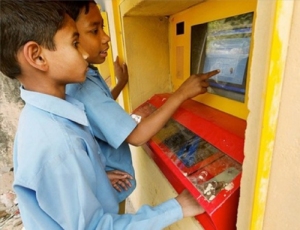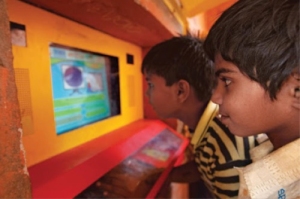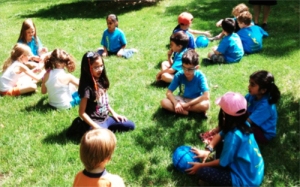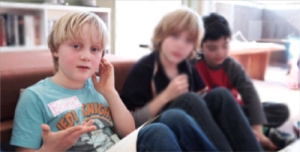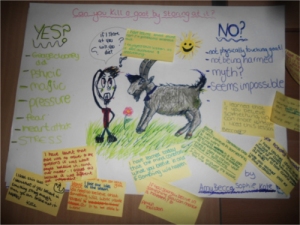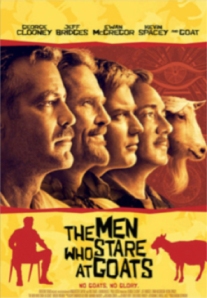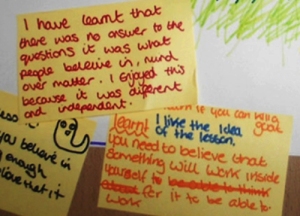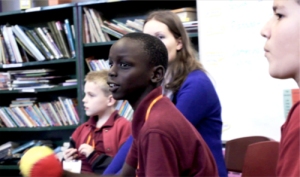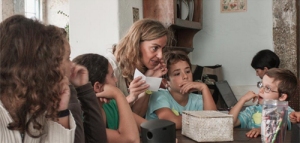Category Archives: Michelle Sowey
Book review: Once Upon an If
Filed under Education, Guest Blogger, Michelle Sowey, Philosophy in Schools
Book review: ‘Provocations: Philosophy for Secondary Schools’ by David Birch
Oddly, very few books exist to help teachers foster philosophical enquiry among high schoolers. Of these few, David Birch’s Provocations is a standout, distinguished by the originality, breadth and richness of its material. Any teacher who regards philosophy as a living, breathing practice will find in Provocations a vast reservoir of stimuli for thinking. It unlocks worlds of wonder and contemplation. Although wonderment may seem like a hard sell to a class of eye-rolling teens, this book is very likely to do the trick, reeling them in with tantalising vignettes and hooking them with contentious questions. “[A] question is an invitation,” Birch says –– and in class discussions, “the best questions are the questions that multiply.”
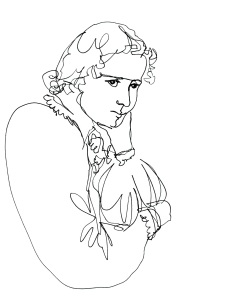
Hannah Arendt…believed that thinking is the quintessence of being alive. Illustration by Tamar Levi.
Not once underestimating the maturity of high schoolers, Birch broaches sophisticated ethical, logical, political and social topics with characteristic pith and earnestness. He believes in students “speaking to find out what they believe”. Accordingly, he suggests that teachers reinvent themselves, shrugging off the mantle of the expert (and the fluency and assurance that go along with it) in favour of listening generously as their students think aloud.
When young people are free to experiment with ideas –– to propose, evaluate, reject or concede arguments as they see fit, rather than swallow readymade conclusions –– philosophy becomes something to do rather than something merely to learn about. It becomes a conscious practice of rationality, balancing open-mindedness and scepticism. Provocations offers prompt after prompt for young people to be curious and receptive learners.
The book opens with a foreword by A. C. Grayling, reminding us that in philosophy we tend not to find clear-cut answers, just more or less convincing (and always contestable) reasons for our views. Birch’s preface sets out his thoughts on the place of philosophy in education. His introduction offers teachers hints on how to encourage meaningful participation in classroom discussion. Much hinges on patient, uninterrupted listening while students explore familiar concepts made strange by their contexts: “Philosophy is a way of relearning language.”
The substance of the book is a diverse selection of engaging short texts, each followed by a thoughtful series of “catalytic questions”. More than 50 philosophical topics feature within themed sections about the World (It), Self (I), Society (We) and Others (You). Included are such intriguing topics as ‘Imperialism and Magic’, ‘Language and Originality’, ‘Perfectibility’ and ‘The Sacred’.
The author doesn’t shy away from raising confronting subjects like gender, suicide and torture, nor does he overlook classic tropes like the nature of time, freedom and autonomy, all presented in fresh and surprising ways.It’s easy to see why the questions of tradition and change, desire and boredom, and belief in God may be especially gripping for students in their adolescent years. Additionally, the inclusion of topics like mass surveillance, consumer marketing and the ethics of eating animals makes Provocations acutely relevant to our contemporary world.
Cerebral but never stuffy, the book introduces complex themes in unpredictable ways. It taps rich veins of cultural and scientific history, ranging freely across historical periods. It interweaves ancient and modern perspectives, philosophies and mythologies of the West and East, events from pivotal moments in world history and recent case studies.
To help students begin to understand death, for instance, Birch marshals contemporary ethnological observations; ideas distilled from the Buddha’s teachings and from Seneca’s writings; modern European philosophies from the idealist, psychoanalytic and existentialist traditions; and even a quote from Hamlet.
The book pulses with interest. Psychiatric reports, a Wagnerian opera narrative, futurologists’ predictions, logic puzzles, boundary-pushing poetry and invented dialogues all rub shoulders with accounts of disputes over workers’ strikes, prisoners’ voting rights, eugenics experiments and the enactment of secularity laws in French schools.
Provocations asks you to “suspend your certainties” and to celebrate the spontaneity and confusion that follows. A sorely-needed antidote to an increasingly results-orientated education system, this book offers much of value not only to philosophy teachers but also to teachers of English, humanities and the arts. Beyond the school gates, this book will find a wider audience among reflective adults. Parents, book clubbers and Philosophy Café enthusiasts are all in for a treat.
Provocations –– so fittingly titled –– will inspire fresh conversations that “crack things wide open”. I expect it will push many young people (and adults, too) to challenge and refine their intuitions, identities and worldviews.
Written by Michelle Sowey runs philosophy programs for children in Australia through her social enterprise, The Philosophy Club. You can follow her thoughts on The Philosophy Club blog and on facebook.
Buy your copy of Provocations in our online shop for only £14.99
Illustrations by Tamar Levi
Filed under Michelle Sowey, Philosophy in Schools
Can you kill a goat by staring at it? A critical look at minimally invasive education
In his renowned ‘Hole in the Wall’ experiments in developing countries, Dr Sugata Mitra gave children access to an internet-connected computer and left them to learn what they could, unsupervised, with apparently remarkable results.
At an internet kiosk in a New Delhi slum, local children figured out how to search the Web, learned English, gleaned information from a variety of websites and taught each other what they had learned. Similarly, with access to a streetside computer in a south Indian village, Tamil-speaking kids managed to figure out basic principles of DNA replication by playing around with English-language web material on their own. ‘Minimally invasive education’ is how Dr Mitra describes this method, alluding to the high-impact, low-disruption techniques of minimally invasive medicine.
Hole in the Wall: Minimally Invasive Learning Stations designed by Dr Sugata Mitra. Top photo: source unknown. Bottom photo by Philippe Tarbouriech, Jaipur, Rajasthan.
This novel educational approach has garnered global attention since Dr Mitra was awarded the $1 million TED Prize for 2013. The prize money funds his TED wish to change the future of learning worldwide by building what he calls the School in the Cloud, composed of decentralised ‘self-organised learning environments’ (SOLEs) in schools and homes. In each SOLE, small groups of children are encouraged to work together, using the internet to answer big questions that interest them, while adult mediators intervene as little as possible in the children’s learning.
Dr Mitra emphasises that adults need no specialist subject knowledge or teaching experience to mediate a SOLE. All they need is a grandmotherly willingness to offer admiration and encouragement, thereby building the children’s confidence and resilience. “Whenever they do anything,” Dr Mitra advises his team of ‘grannies’, “you just say ‘well, wow! I mean, how did you do that? … Gosh, when I was your age I could never have done that!’” Meanwhile, the children are given a question to investigate and left to their own devices. Dr Mitra speculates that “if you allow the educational process to self-organise, then learning emerges… The teacher sets the process in motion, and then she stands back in awe and watches as learning happens.”
Children at Eurekamp! Philosophy summer camp, Edmonton, Canada
This approach shares certain promising features with philosophical enquiry as it is widely practiced with primary school children. Both are curiosity-driven, collaborative enterprises that seek to engage children’s interest in big questions. Both support children in exploring ideas and sharing discoveries. And both offer the prospect of intellectual adventures that spring from children’s sense of wonder and their ability to work together. What’s more, Dr Mitra’s proposed curriculum of big questions includes many deeply philosophical ones, such as ‘Can anything be less than zero?’, ‘Will robots be conscious one day?’ and ‘What is altruism?’ In each of these respects, Dr Mitra’s vision closely parallels our ideals and methods of collaborative philosophical enquiry.
Children at The Philosophy Club, Sydney, Australia
There are two major points of difference, though, and it’s here that I see cracks in the veneer of minimally invasive education. It differs from collaborative enquiry in that (1) it features the internet as a principal learning medium and (2) it renounces the guidance of qualified teachers or practitioners.
A hallmark of Dr Mitra’s approach is that children are encouraged to conduct unguided internet searches. There is no provision for children to develop the range of skills needed for such a pursuit, however. The risks here are well articulated by media critic Howard Rheingold:
Digital media and networks can only empower the people who learn how to use them — and pose dangers to those who don’t know what they are doing … Those people who do not gain fundamental literacies of attention, crap detection, participation, collaboration, and network awareness are in danger of all the pitfalls critics point out — shallowness, credulity, distraction, alienation, addiction. I worry about the billions of people who are gaining access to the Net without the slightest clue about how to find knowledge and verify it for accuracy, how to advocate and participate rather than passively consume.
In particular, without some education about how to assess the credibility of internet sources, children can easily go astray. Inadvertently, Dr Mitra himself illustrates this danger in his SOLE Toolkit, where the showcase example of children’s work in a SOLE betrays not only factual errors but also egregious failures of reasoning.
Students’ work showcased in the SOLE Toolkit. Photo by Amy Dickinson, Newcastle, UK
In the example, children investigated the question ‘Can you kill a goat by staring at it?’ – a question you might suppose has a clear-cut negative answer. The children responded by jotting down reasons for and against the possibility in ‘Yes?’ and ‘No?’ columns. Among their reasons in the ‘No?’ column we find ‘myth?’ and ‘seems impossible’, suggesting a degree of scepticism. However, in the ‘Yes?’ column – in support of the notion that you can kill a goat by staring at it – they cited a longer list of reasons including ‘psychic’, ‘magic’, and ‘George Clooney did’. (This last comment refers to the movie The Men Who Stare At Goats, based on Jon Ronson’s nonfiction book about an experimental unit of the US Army whose ‘warrior monks’ sought to harness paranormal phenomena for military purposes.)
Can you kill a goat by staring at it? George Clooney did.
Disturbingly, in their post-activity reflections, the children all drew highly credulous conclusions that supported paranormal claims – conclusions such as “mind over matter”, “if you believe something, you can make it happen” and “the mind can fix problems without aid”. Another concluded that the facts are relative to one’s beliefs: “I have learnt that there was no answer to the question, it was what people believed in.” Adult mediators shouldn’t simply stand back and admire these answers.
Close-up of students’ work in a SOLE
Dr Mitra maintains that “our biggest job in this information-saturated world is to give the child an armour against doctrine.” The children’s responses to the staring-at-goats question strongly suggests that unguided, peer-supported internet browsing fails to provide this armour. It’s easy to imagine children in similar circumstances floundering with any number of other (largely settled) questions, such as whether the theory of evolution is sound, whether human-induced climate change is demonstrable, and whether homeopathy is therapeutically effective.
If we want to equip children to challenge faulty arguments and to question claims that are dogmatic, propagandistic, biased, pseudoscientific or downright erroneous, then we need a different approach. We need to make sure that kids develop thinking and reasoning skills alongside skills in research and information awareness. For this, the support of a competent guide is indispensable, equipping children not only to assess the reliability of different sources but also to evaluate the many arguments they will encounter.
Students in the Winning Words after-school Philosophy program, Chicago, USA. Photo by Drew Reynolds.
In his TED talk, Dr Mitra explains his scepticism towards formal schooling in the following way. Our present-day school system – with its emphasis on standardisation – was devised in the Victorian era, with the intent to produce identical graduates to serve the British Empire’s bureaucratic machine. The system was so robust that, to this day, it continues to produce identical people for a machine that no longer exists.
“Could it be that you don’t need to go to school at all?” Dr Mitra therefore ponders, before asking whether ‘knowing’ will eventually become obsolete. I’d reply that even with the internet at our fingertips (and perhaps soon on the bridge of our nose), there’s something we will always need to know: How can we become better thinkers?
To dismiss the infrastructure of schooling altogether because of traditional standardisation is to throw the baby out with the bathwater. Surely it makes more sense to repurpose that infrastructure in ways that better nourish children’s curiosity, critical thinking and creative exploration.
Participants in the Big Questions philosophy mentoring program, Melbourne, Australia
While I share Dr Mitra’s passion for the benefits of small-group enquiry-based learning, I think the idea of minimally invasive education fails for the following reason: it’s not plausible to suppose that children in SOLEs can self-organise their way to an expanded repertoire of thinking skills. Certainly Dr Mitra offers no systematic empirical evidence that they can. (To my knowledge, his own research on SOLEs has not been published in a peer-reviewed journal.) Published research indicates that children may in fact lack the cognitive skills needed to make unaided peer-supported enquiry productive.
Good thinking doesn’t usually occur spontaneously, in schools or elsewhere. It has to be cultivated with the help of (sometimes counterintuitive) strategies like being actively open-minded, questioning assumptions, making sound inferences and entertaining counter-opinions. Facilitating collaborative dialogues is an obvious way to help children practise these strategies. The facilitator provides scaffolding while the children do the intellectual heavy lifting: examining conflicting opinions, evaluating arguments, generating alternatives, drawing logical connections and making reasoned judgements.
In this context, guided discovery learning activities (including internet research tasks) and dialogue-based collaborative enquiries could complement each other well. The big questions that Dr Mitra proposes in the SOLE Toolkit are splendid catalysts for research and discussion (although the theoretical questions aren’t distinguished from the empirical ones, and a philosophically astute facilitator would certainly want to highlight the epistemic differences between the two).
Ana Aires Breysse with a group of free thinkers (Livres Pensadores), Lisbon, Portugal
Whether or not they participate in SOLEs, children will increasingly rely on the internet for their learning, so it’s more important than ever that we help them skilfully deploy critical and creative thinking. In the era of ‘personalised search’, with Google and countless other websites constructing a filter bubble for each user, the answers that children are likely to find online are heavily skewed towards those that they’ve previously found. This tends to limit exploration and amplify confirmation bias, narrowing minds rather than broadening them.
What’s more, as we saw in the staring-at-goats example, the internet is an unpredictable clearinghouse of truths, partial-truths and falsehoods. When I was growing up, pre-internet, my father used to jokingly refer to an information hierarchy of ‘true facts, facts, factoids and true falsehoods’. All of these have since proliferated on the internet’s poorly-calibrated spectrum of knowledge. As Kevin Kelly, founding editor of Wired magazine, says of the internet age:
…my knowledge is now more fragile. For every accepted piece of knowledge I find, there is within easy reach someone who challenges the fact. Every fact has its anti-fact. The Internet’s extreme hyperlinking highlights those anti-facts as brightly as the facts. Some anti-facts are silly, some borderline, and some valid. You can’t rely on experts to sort them out because for every expert there is an equal and countervailing anti-expert. Thus anything I learn is subject to erosion by these ubiquitous anti-factors.
We need the incisiveness and probing of critical and creative thinking to get deep into the viscera of the facts and anti-facts, the experts and anti-experts. And we need the incisiveness and probing of good teachers to go deep into children’s thought-space: to discover what they’re understanding and what they’re not, yet.
Minimally invasive education skates the surface of understanding – it doesn’t plumb the depths. It’s limited, just as minimally invasive medicine is: X-rays don’t pass through dense tissue; ultrasounds can’t view past bone; keyhole surgery isn’t always possible.
Sometimes we need to be cut wide open.
Children at The Philosophy Club, Sydney, Australia
Michelle Sowey runs Philosophy programs for children in Australia through her social enterprise, The Philosophy Club. You can follow her thoughts on The Philosophy Club blog and on Facebook.
Filed under Guest Blogger, Michelle Sowey

